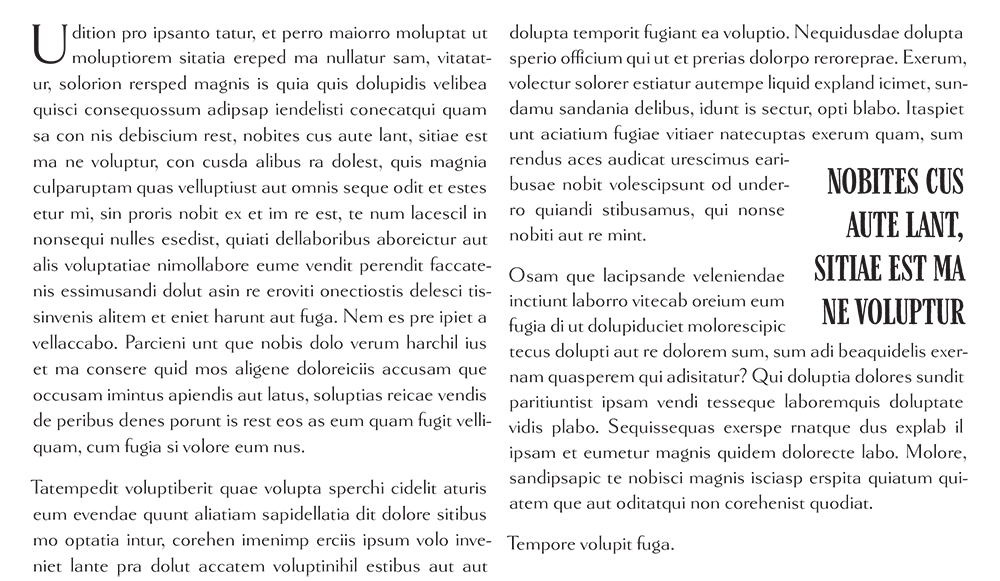Substack recently introduced a new “Pull Quote” feature in addition to its standard “Block Quote.” I noticed in a discussion thread that many users were confused about the applications of these two styles of quotes, and some of the blogs I visit and newsletters I receive (even a few from prominent authors with backgrounds in journalism and tons of paid subscriptions) misuse them because most people are new to editing their own layouts.
In my other life, I’m an editorial designer, among other things, so I thought this week I’d do something a little different and offer a brief guide. I know a lot of readers who subscribe here are also writers with their own publications and it might be handy to review the conventions associated with these styles.
Block Quotes
The block quote is used as a visual cue to the reader that the text contained within it is a quote from a source external to the author(s) of the piece. So, for example, I might introduce the subject of quotations with a quote about quotations from the always opinionated Oscar Wilde:
Most people are other people. Their thoughts are someone else's opinions, their lives a mimicry, their passions a quotation.
While quotations may, of course, be run into the body of the text, the block quote allows the reader to easily differentiate words that are not original to the text. The quotation is integrated into the flow of the text, meaning it should read seamlessly as one. There is no need for quotation marks (“ ”) in this format.
In print, a block quote would normally be restricted to a longer passage of more than four lines (according to MLA standards) or forty words (according to the APA standard) or anything over a whopping one hundred words according to the Chicago Manual of Style (CMOS). But because digital layouts are so visually sterile, I think it’s acceptable to put shorter quotes in blocks to break up the endless flow of text as well as help readers differentiate between and easily locate quotations. Use your best judgment and err on the side of whatever facilitates reader experience rather than strict rules.
So far, so good.
Pull Quotes
The biggest misunderstandings arise around the use of pull quotes. The purpose of a pull quote is to feature or highlight an important or enticing excerpt from within the story. This text is brief, and depending on the nature of the piece, can be derived from the author’s content or, in the case of journalistic pieces, from previously unpublished source quotes like interviews. It is generally poor practice to feature or highlight words that are not the author’s unless the quotations in the piece are original to it.
For example, if in my article I quoted Rudyard Kipling:
He wrapped himself in quotations—as a beggar would enfold himself in the purple of Emperors.
it would be awkward to highlight any portion of this in a pull quote. However, if I then made some pithy observation or commentary on the material I quoted, I might determine that this was central to the theme of my piece and worthy of highlighting in a pull quote, like so:
Some pithy observation or commentary on the material I quoted…
This is Substack’s version of the pull quote and you can see how this is visually different from its block quote. Do note that what you see in this preview is how the pull quote will appear in your emails and online: The text will automatically be italicized. It will remain centered, though this alignment disappears if I apply different headings formatting from the “Styles” dropdown; however, I can add bolding without affecting the center alignment. It is also set off with line dividers.
How to use Pull Quotes
Choose wisely
Because readers will understand pull quotes to be special, be sure to choose them carefully. The excerpt you choose should have meaning within the piece and also have the power to affect the curiosity or understanding of the reader, depending on your reason for selecting it. Do you want to grab a reader’s attention? Draw them in? Highlight a theme? Bolster a point?
Pull quotes can serve many different purposes, and knowing yours before you choose any old chunk of text will be key to getting the most from your quote.
Place with care
Unlike block quotes, which integrate with the flow of text, pull quotes stop readers in their tracks. They are roadblocks set in the page and can either direct or distract the reader depending on placement.
PULL QUOTES STOP READERS IN THEIR TRACKS
Where you place a pull quotes will have an impact on how your text is read. In print, pull quotes are usually set off in their own text box, employ a different font, and have the body text wrapped around them with adequate spacing to give them room to breathe. They draw the eye before the reader begins an associated column of text, like the card stuck to a package waiting to be opened. They’re more visually appealing and noticeable, but recreating them online presents a host of other challenges, including how they will scale on mobile devices and be read by AI readers and accessibility tools. Substack seems to have solved this dilemma by simply placing them in line with the text. What they sacrifice in aesthetics they gain in simple functionality.
However, that doesn't mean they should just be dropped anywhere. Avoid throwing one down next to a block quote, a heading, a photo, the text you’re quoting, and for the love of all that is good in the world, please keep them away from “share” and “subscribe” buttons.
While we’re at it, can we have a little word about those buttons? There are many options for creating a text break, such as the line divider I just used. No, spaces don’t work. Substack just reabsorbs them.
But, one could insert a custom image used as an ornamental divider like this:
Or simply opt for the classic font-based dividers (a bit awkward with left-alignment, I agree):
***
Or an image of any kind will serve the purpose of breaking a scene or changing the subject.
But breaking up text with buttons like these?:
Inserting something like this is as distracting as an advertisement on an ordinary news site, and disrupts the flow of reading and thought:
Maybe that’s the effect you want. But on another level, it implies to the reader that the article is at an end. After all, why would I subscribe or share something I hadn’t yet finished reading? I might prematurely share it and find that the last few paragraphs are a manifesto calling for the nomination of Spongebob to the Supreme Court. Fool me once. And believe me, I’ve read many a post that I nodded along with until it took a bizarre turn at the end. Whatever Substack tells you, and however they plead, I beg you to save these calls to action for the end.
Anyway, now that I have thoroughly distracted and annoyed you, back to pull quotes…
Preview or Review?
With regard to placement, there are two main strategies, and the nature of the quote you choose will determine its placement.
The “preview” quote is one you place anywhere before its appearance in the body of the text. On some level, any pull quote could be a “preview” if it draws enough attention to itself and earns a premature glance from the reader; however, intentionally placing it early to grab eyeballs is a real strategy. This is the riskiest of the methods, but if you choose something enticing that can stand outside the context of the article or story, then this can be a powerful lure for readers, as they will be curious to connect the dots.
For example, rather than providing a chapter summary for my serialized novel, Of Wind and Wolves, I often use pull quote-style excerpts as my chapter descriptions. They serve as “previews” to hopefully pique the reader’s curiosity about the upcoming chapter, as I did with this one from Chapter Thirty-Two: Rathagos:
Without its head, a snake eventually loosens its grip.
The chapter deals with the difficult choices that must be made in the aftermath of a high-ranking warrior’s (the titular Rathagos) disobedience and the realization that he is not alone in his defiance. What is the “snake” referred to here, on what does it have a grip, and will it lose its “head”? Hopefully readers of this pull quote will want these questions answered and read on!
However, this technique can also backfire unpleasantly if you introduce a pull quote before you introduce enough context to orient readers, like this:
those kernels will litter your piece until they become meaningless
What the fuck does that even mean? It doesn’t connect with anything you’ve read yet, so it just dangles there, irrelevantly, until it gathers context. This doesn’t help you or your readers and probably just annoys them. There is nothing worse than being force-fed a pull quote before you have the necessary information to contextualize it, and articles that do this are on very thin ice.
There is nothing worse than being force-fed a pull quote before you have the necessary information to contextualize it
This is when the article would be better served by the “review” technique. You deploy this pull quote after the original text appears in the body of the article, as I did with the quotation above. This way, it serves to emphasize or reiterate an important point you’re trying to drive home, or sum up the thesis of your argument rather than introducing it before the argument has been made. It becomes an exclamation point that sears the most obviously brilliant and utterly profound statement of your piece into the mind of your reader at just the right moment.

Use Sparingly
Part of what makes the pull quote so effective is that it takes something intriguing in the article—the kernel at the heart of the piece, an important theme—and “pulls” it out of the text to where the reader can’t ignore it. But if you do this too often, those kernels will litter your piece until they become meaningless—or worse, annoying. Each article or chapter should have one, maybe two quotes that can serve as the thesis, theme, punchline, focus, or entry point for the reader, and that’s enough.
If it is an exceptionally long or complex article, each section might be able to sustain its own pull quote, but keep them brief and probably use the “review” style rather than the “preview” style to help reinforce a key point of the section.
Block and Tackle
A fine quotation is a diamond in the hand of a man of wit and a pebble in the hand of a fool.
—Joseph Roux
I hope this was helpful and you have a better sense of the way these two styles of quotation work both in print and online. While you lose some of the versatility and visual appeal you get with a print layout, a simple, clear block quote or pull quote can definitely add clarity and visual interest to otherwise bland digital layouts. Hopefully you’re ready to tackle block and pull quotes with style and ease!
Did I leave anything out? If you have any questions, feel free to ask them in the comments or send me an email.





Thanks for this informative article. It answered a few questions I didn't even know I had!
I am not a writer, but I am a reader, and I found your information to be quite helpful. Very detailed and you obviously put a lot of time and work into it. So thank you for that.